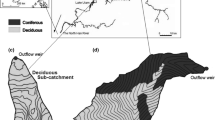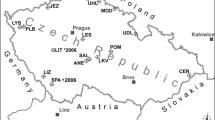Abstract
The biogeochemical input-output fluxes of two forested catchments with contrasting levels of atmospheric deposition were investigated in Germany. This paper focuses on the effects of recent changes in atmospheric inputs on the chemical composition in the soil solution and stream. The catchment 'Schluchsee' (Black Forest; SW Germany) is characterized by relatively low atmospheric inputs whereas 'Rotherdbach' (Ore Mountains; E Germany) received significant amounts of acid deposition (mainly originating from SO2 emissions) until recent years. Both sites reveal decreases in H+ and S deposition during the 1990s. This pattern is typical when compared to trends in Europe. In response to the reduced S deposition, soil solution and streamwater SO4 2− concentrations decreased significantly. A net release of SO4 2− (output > input) was observed at both sites due to the release of S previously stored in the soil. The level of N deposition was more or less constant at both sites. At Schluchsee, NO3 − concentration in streamwater remained more or less unchanged, whereas a decrease at Rotherdbach was observed. A recovery from acidification was found in seepage water as indicated by increasing acid neutralizing capacity (ANC). Streamwater ANC increased only in the permanently acidified Rotherdbach. No change of ANC was observed in the Schluchsee stream, which was characterized by episodic acidification during high-flow conditions. Nevertheless, the key factor controlling the recovery from surface water acidification was the type, amount and distribution of stored S pools in the ecosystem. Thus, time series analysis of long-term data of input-output chemistry can be a valuable instrument in order to improve the understanding of linked terrestrial-aquatic systems and give useful clues for modeling efforts.
Similar content being viewed by others
References
Aber J.D., Nadelhofer K.J., Steudler P. and Melillo J.M. 1989. Nitrogen saturation in northern forest ecosystems. BioScience 39: 378–386.
Abiy M. 1998. Standortskundliche und hydrochemische Untersuchungen in zwei Wassereinzugsgebie-ten des Osterzgebirges. PhD Thesis, Dresden University of Technology.
Abraham J., Cichanowicz-Kusztal R., Drüeke M., Jodlowska-Opyd G., Kallweit D., Keder J. et al. 2000. Common report on air quality in the black triangle region 1999.
Ågren G.I. and Bosatta E. 1988. Nitrogen saturation of terrestrial ecosystems. Environmental Pollutn 54: 185–198.
Alewell C. 1995. Sulfat-Dynamik in sauren Waldböden-Sorptionsvermögen und Prognose bei nachlassenden Depositionen. Bayreuther Forum ökologie, Vol. 19, 185 p.
Alewell C., Armbruster M., Bittersohl J., Evans C., Meesenburg H., Moritz K. et al. 2001. Are there signs of acidification reversal after two decades of reduced acid input in the low mountain ranges of Germany? Hydrol. and Earth Syst. Sci. 5: 367–378.
Alewell C., Manderscheid B., Bittersohl J. and Meesenburg H. 2000b. Is acidification still an ecological threat? Nature 407: 856–857.
Alewell C., Manderscheid B., Gerstberger P. and Matzner E. 2000a. Effects of reduced atmospheric deposition on soil solution chemistry and elemental contents of spruce needles in NE-Bavaria, Germany. J. Plant Nutr. Soil. Sci. 163: 509–516.
Armbruster M. 1998. Zeitliche Dynamik der Wasser/-und Elementflüsse in Waldökosystemen. Freiburger Bodenkundl. Abh Vol. 38., 331 p.
Armbruster M., Köhler H. and Feger K.H. 2000. Chemical composition of first-order streams in the upper Black Forest-Variability related to runoff dynamics and soil liming (in German). Forstw. Cbl. 119: 249–262.
Brahmer G. 1990. Wasser-und Stoffbilanzen bewaldeter Einzugsgebiete im Schwarzwald unter besonderer Berücksichtigung naturräumlicher Ausstattung und atmogener Einträge. Freiburger Boden-kundl. Abh Vol. 25., 295 p.
Cummins T., Beier C., Blanck K., de Visser P.H.B., Farrell E.P., Rasmussen L. et al. 1995. The EX-MAN project. Biogeochemical fluxes in plantation forests on acid soils. Water Air Soil Pollut. 85: 1653–1658.
Discroll C.T. 1984. A procedure for the fractionation of aqueous aluminum in dilute acidic waters. Int. J. Environ. Anal. Chem. 16: 267–283.
Evans C.D., Cullen J.M., Alewell C., Kopácek J., Marchetto A., Moldan F. et al. 2001. Recovery from acidification in European surface waters. Hydrol. and Earth Syst. Sci. 5: 283–297.
Feger K.H. 1993. Bedeutung von ökosysteminternen Umsätzen und Nutzungseingriffen für den Stoff-haushalt von Waldökosystemen. Freiburger Bodenkundl. Abh Vol. 31., 237 p.
Feger K.H. 1995. Solute fluxes and sulfur cycling in forested catchments in SW Germany as influenced by experimental (NH4)2 SO4 treatments. Water Air Soil Pollut. 79: 109–130.
Feger K.H. 1997. Biogeochemistry of Mg in forest ecosystems (Chapter 3). In: Hüttl R.F. and Schaaf W. (eds), Magnesium Deficiency in Forest Ecosystems. Nutrients in Ecosystems 1. Kluwer Academic Publishers, Dordrecht, pp. 67–99.
Fink S., Feger K.H., Gülpen M., Armbruster M. and Lorenz K. 1999. Magnesium-Mangelvergilbung an Fichte-Einfluss von frühsommerlicher Trockenheit und Dolomit-Kalkung. FZKA-BWPLUS-Ber-ichtsreihe 25, http://bwplus.fzk.de/berichte/SBer/PEF197001SBer.pdf.
Flieger A. and Toutenburg H. 1995. SPSS Trends für Windows. Arbeitsbuch für Praktiker. Prentice Hall, München.
Hirsch R.M., Slack J.R. and Smith R.A. 1982. Techniques of trend analysis for monthly water quality data. Water Resour. Res. 18: 107–121.
Hirsch R.M. and Slack J.R. 1984. A non-parametric test for seasonal data with serial dependence. Water Resour. Res. 20: 727–732.
Hornung M., Roda F. and Langan S.J. 1990. A review of small catchment studies in western Europe producing hydrochemical budgets. CEC Air Pollution Report 28.
Kreutzer K. 1994. The influence of catchment management processes in forests on the recovery in fresh waters. In: Steinberg C.E.W. and Wright R.F. (eds), Acidification of Freshwater Ecosystems: Impli-cations for the Future. Dahlem Workshop Reports. Environmental Sciences Research Report 14. Wiley and Sons, Chichester, pp. 325–344.
Langusch J. 1995. Untersuchungen zum Ionenhaushalt zweier Wassereinzugsgebiete in verschiedenen Höhenlagen des Osterzgebirges. PhD Thesis, Dresden University of Technology.
Likens G.E., Bormann F.H., Pierce R.S., Eaton J.S. and Johnson N.M. 1977. Biogeochemistry of a Forested Catchment. Springer, New York.
Manderscheid B., Schweisser T., Lischeid G., Alewell C. and Matzner E. 2000. Sulfate pools in the weathered bedrock of a forested catchment. Soil Sci. Soc. Am. J. 64: 1078–1082.
Marques C.M. 1999. Eintrag von luftgetragenen partikelgebundenen Spurenstoffen in Wälder durch die trockene Deposition. Wissenschaftlicher Verlag, Berlin.
Mayer B., Feger K.H., Giesemann A. and Jäger H.J. 1995. Interpretation of sulfur cycling in two catch-ments in the Black Forest (Germany) using stable sulfur and oxygen isotope data. Biogeochemistry 30: 31–58.
Meesenburg H., Meiwes K.J. and Rademacher P. 1995. Long term trends in atmospheric deposition and seepage output in northwest German forest ecosystems. Wat. Air and Soil Poll. 85: 611–616.
Mitscherlich G. 1981. Wald, Wachstum und Umwelt. Vol. 2. Waldklima und Wasserhaushalt, Sauerländer, Frankfurt.
Moldan F. and Wright R.F. 1998. Changes in runoff chemistry after five years of N addition to a forested catchment at Gardsjön, Sweden. Forest Ecol. and Management 101: 187–197.
Nebe W. 1964. Die chemische Zusammensetzung der wichtigsten Grundgesteine Sachsens als Grundlage für eine Beurteilung der Nährstoffverhältnisse in Waldböden. Jb. Staatl. Mus. Mineral. Geol. Dresden 10: 351–386.
Nebe W., Roloff A. and Vogel M. (eds) 1998. Untersuchungen von Waldökosystemen im Erzgebirge als Grundlage für einen ökologisch begründeten Waldumbau. Forstwiss. Beiträge Tharandt (Contribu-tions to Forest Science) 4. Department of Forest Sciences, Technical University of Dresden, Tharandt.
Nilsson J. (ed.) 1986. Critical Loads for Nitrogen and Sulphur. NORD Miljørapport 11. Nordic Council of Ministers, Copenhagen, 232 p.
Prechtel A., Alewell C., Armbruster M., Bittersohl J., Cullen J., Evans C.D. et al. 2001. Response of sulphur fluxes in European freshwater to decreasing sulphate deposition. Hydrol. and Earth Syst. Sci. 5: 311–325.
Prietzel J. and Feger K.H. 1996. Dynamik von Aluminium und ökotoxischen Al-Bindungsformen in kleinen Fließgewässern nach Forstdüngung mit sulfatischen Magnesiumsalzen. Vom Wasser 87: 387–408.
Prietzel J. 1998. Untersuchungen zum S-Haushalt-Zusammenfassende Diskussion. In: Raspe S., Feger K.H. and Zöttl H.W. (eds), ökoystemforschung im Schwarzwald. Auswirkungen von atmogenen Einträgen und Restabilisierungsmaßnahmen auf den Wasser-und Stoffhaushalt von Fichtenwäldern. Verbundprojekt ARINUS. Umweltforschung in Baden-Württemberg. ecomed Verlag, Landsberg, pp. 375–386.
Reuss J.O. and Johnson D.W. 1986. Acid deposition and the acidification of soils and waters. Ecological studies 59. Springer, New York.
Stoddard J.L., Jeffries D.S., Lükewille A., Clair T.A., Dillon P.J., Driscoll C.T. et al. 1999. Regional trends in aquatic recovery from acidification in North America and Europe. Nature 401: 575–578.
Stoddard J.L. and Traaen T.S. 1995. The stages o nitrogen saturation: classification of catchments included in _ICP on Waters_. In: Hornung M., Sutton M.A. and Wilson R.B. (eds), Maping and modelling of critical loads for nitrogen-a workshop report. Proceedings of the Grange-over-Sands Workshop 24–26 Oct. 1994. Institute of Terrestrial Ecology, Edinburgh, UK, pp. 69–76.
Stoddard J.L. 1994. Long-term changes in watershed retention of nitrogen: its causes and aquatic consequences. In: Baker L.A. (ed.), Environmental Chemistry of Lakes and Reservoirs. Advances in Chemistry 237. American Chemical Society, Washington, pp. 223–284.
Swank T.S. and Crossley D.A. (eds) 1988. Forest Hydrology and Ecology at Coweeta. Ecological Studies 66. Springer, New York.
Tamm C.O. 1991. Nitrogen in terrestrial ecosystems. Questions of productivity, vegetational changes, and ecosystem stability. Ecological Studies 81. Springer, New York.
Tarrasón L. and Schaug J. (eds) 1999. Transboundary acid deposition in Europe. EMEP (Cooperative Programme for Monitoring and Evaluation of the Long-Range Transmission of Air pollutants in Europe) summary report 1999. Norwegian Meteorological Institute Research Report 83.
Ulrich B. 1983. Interactions of forest canopies with atmospheric constituents: SO2 alkali and earth alkali cations and chroride. In: Ulrich B. and Pankrath J. (eds), Effects of Air Pollutants in Forest Ecosystems. Reidel Publ. Co., Dordrecht, pp. 33–45.
Ulrich B. 1991. Rechenweg zur Schätzung der Flüsse in Waldökosystemen. Identifizierung der sie be-dingenden Prozesse. In: Volker G. and Friedrich J. (eds), Beiträge zur Methodik der Waldökosys-temforschung. Ber. d. For. Zentr. Walökosysteme (B) Vol. 24, pp. 204–210.
van Miegroet H. 1994. The relative importance of sulfur and nitrogen compounds in the acidification of fresh water. In: Steinberg C.E.W. and Wright R.F. (eds), Acidification of Freshwater Ecosystems: Implications for the Future. Dahlem Workshop Reports. Environmental Sciences Research Report 14. Wiley and Sons, Chichester, pp. 33–49.
Veselý J., Majer V. and Norton S.A. 2002. Heterogenous response of central European streams to decreased acidic atmospheric deposition. Environmental Pollution 120: 275–281.
Wright R.F., Alewell C., Cullen J.M., Evans C.D., Marchetto A., Moldan F. et al. 2001. Trends in nitrogen deposition and leaching in acid-sensitive steams in Europe. Hydrol. and Earth Syst. Sci. 5: 299–310.
Wright R.F. and van Breemen 1995. The NITREX project: an introduction. Forest Ecol. Manage. 71: 1–6.
Author information
Authors and Affiliations
Corresponding author
Rights and permissions
About this article
Cite this article
Armbruster, M., Abiy, M. & Feger, Kh. The biogeochemistry of two forested catchments in the Black Forest and the eastern Ore Mountains (Germany). Biogeochemistry 65, 341–368 (2003). https://doi.org/10.1023/A:1026250209699
Issue Date:
DOI: https://doi.org/10.1023/A:1026250209699




